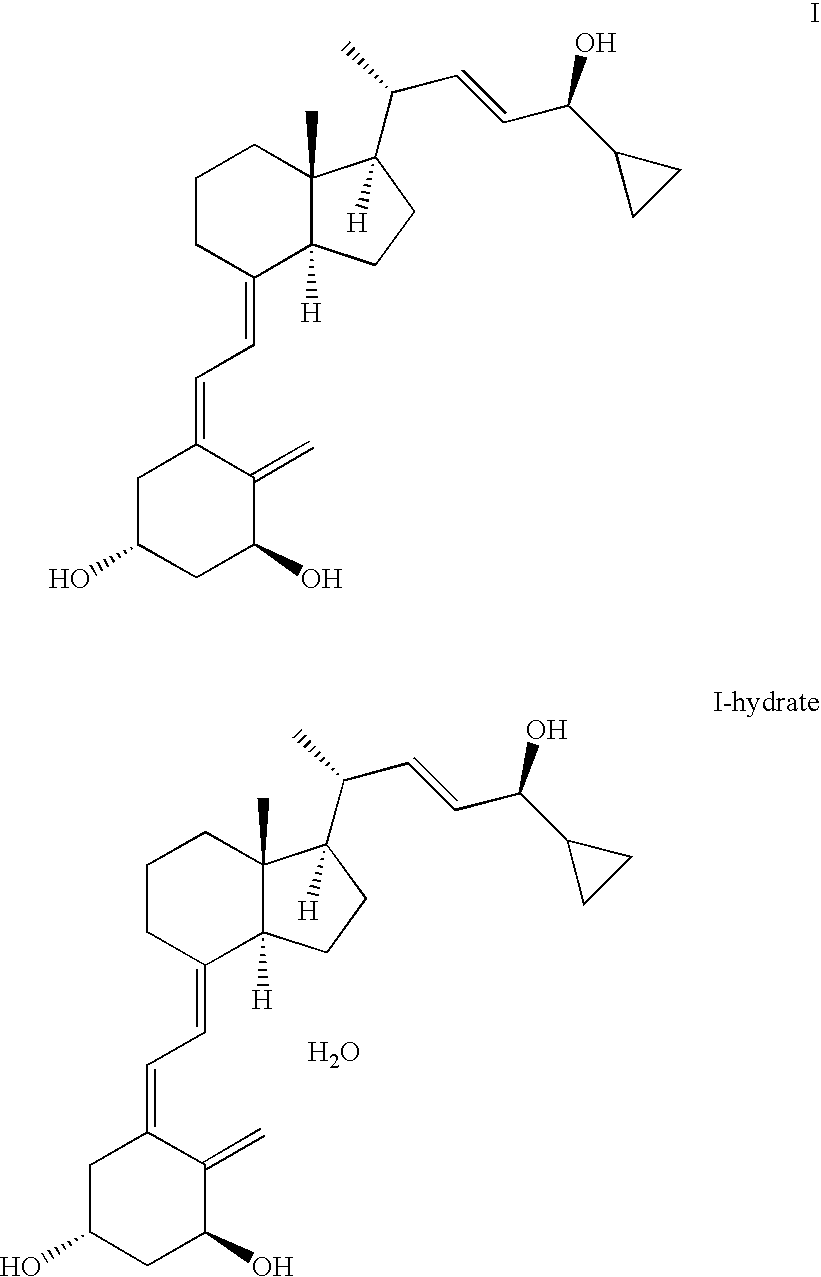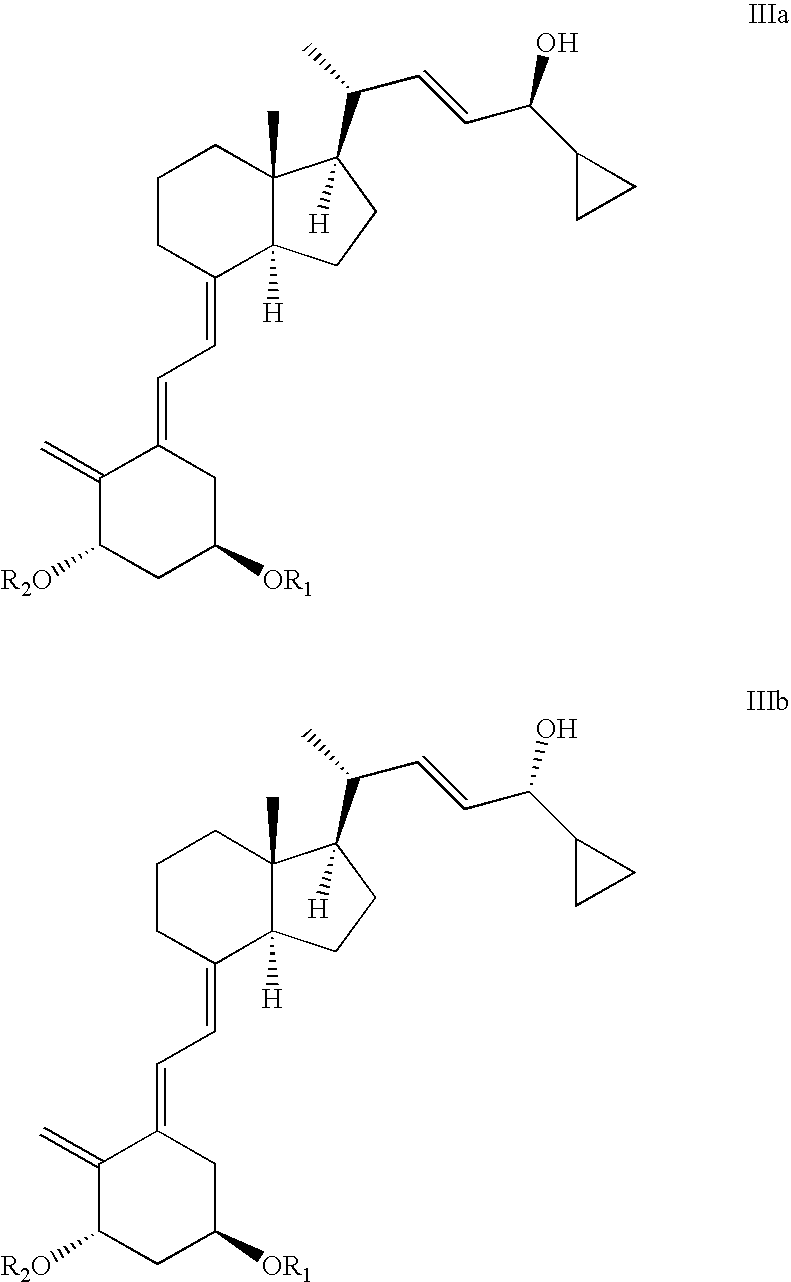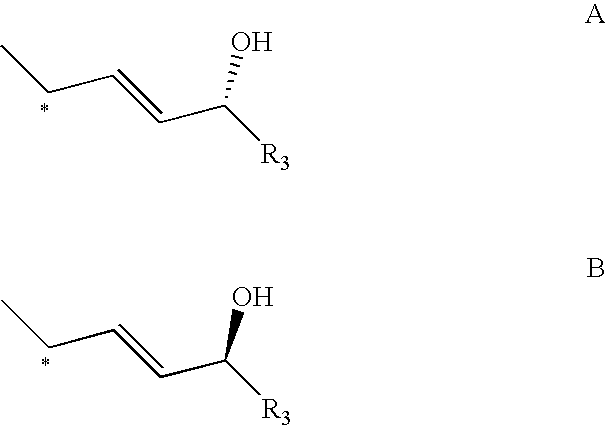Epimerisation of Allylic Alcohols
a technology of allylic alcohol and allylic alcohol, which is applied in the field of compound epimerisation, can solve the problems of low high waste, and unfavorable process economics, and achieves the effect of improving overall yield and process productivity, and being easy to operate on an industrial scal
- Summary
- Abstract
- Description
- Claims
- Application Information
AI Technical Summary
Benefits of technology
Problems solved by technology
Method used
Image
Examples
embodiments
[0064] In a preferred embodiment of the present invention, the vitamin D analogue fragment is represented by either of fragment F, G, H, J, K, or L,
[0065] wherein R1 and / or R2 may be the same or different and represent hydrogen or a hydroxy protecting group.
[0066] In another preferred embodiment of the present invention R1 and R2 represent alkylsilyl or hydrogen.
[0067] In another preferred embodiment of the present invention R1 and R2 represent tert-butyldimethylsilyl.
[0068] In another preferred embodiment of the present invention R3 is cyclopropyl or —C(CH3)2—C(O)—O—CH(CH3)2.
[0069] In another preferred embodiment of the present invention the configuration at the carbon atom C-20 of the side chain marked with an asterisk is (R) and the configuration at C-17 or the C-17 analogous position is the same as in natural vitamin D3.
[0070] In another preferred embodiment of the present invention the epimer is compound IIIba or the epimeric mixture comprises compound IIIaa and IIIba. ...
example 1
MC898 / MC901
[0113] 1(S),3(R)-bis(tert-butyl-dimethylsilyloxy)-20(R)-(3′-cyclopropyl-3′(R)-hydroxyprop-1′(E)-enyl)-9,10-secopregna-5(E),7(E),10(19)-triene (IIIb: R1, R2=tert-butyldimethylsilyl) (10 mg), THF (1 ml) and aqueous sulphuric acid (0.4 ml, pH 1.7) were mixed in a test tube. After standing overnight at room temperature, HPLC-analysis (normal phase silica 20 cm analytical column, 4 ml / min., AcOEt / n-hexane 4 / 96 (v:v) indicates ca. 40% of the starting epimer and ca. 45% of 1(S),3(R)-bis(tert-butyl-dimethylsilyloxy)-20(R)-(3′-cyclopropyl-3(S)′-hydroxyprop-1′(E)-enyl)-9,10-secopregna-5(E),7(E),10(19)-triene (IIIa: R1, R2=tert-butyldimethylsilyl) together with ca. 12% of two major and less polar impurities of unknown structure.
example 2
[0114] A mixture containing ca. 95% of 1(S),3(R)-bis(tert-butyl-dimethylsilyloxy)-20(R)-(3′-cyclopropyl-3′(R)-hydroxyprop-1′(E)-enyl)-9,10-secopregna-5(E),7(E),10(19)-triene (IIIb: R1, R2=tert-butyldimethylsilyl) and 1, R2=tert-butyldimethylsilyl) (ca. 12 kg) was dissolved in a mixture of acetone (58 l) and THF (58.5 l). A solution of sodium hydrogen sulphate (0.3 kg) in water (20 l) (pH 1.58) was added with stirring keeping the temperature in the interval of 20-25° C. After 220 minutes a saturated solution of NaHCO3 (6 l) was added to the reaction mixture. The organic solvents were mostly removed in vacuo and the remainder was redissolved in ethylacetate (100 l). The organic solution was then washed with brine (2 l saturated NaCl-solution in 180 l water). The ethylacetate was then removed in vacuo, the remainder was redissolved in hexane, and the epimeric mixture containing IIIa and IIIb (R1, R2=tert-butyldimethylsilyl) in an epimeric ratio of 67:33 as checked by HPLC {Column LiChr...
PUM
| Property | Measurement | Unit |
|---|---|---|
| temperature | aaaaa | aaaaa |
| temperature | aaaaa | aaaaa |
| temperature | aaaaa | aaaaa |
Abstract
Description
Claims
Application Information
 Login to View More
Login to View More - R&D
- Intellectual Property
- Life Sciences
- Materials
- Tech Scout
- Unparalleled Data Quality
- Higher Quality Content
- 60% Fewer Hallucinations
Browse by: Latest US Patents, China's latest patents, Technical Efficacy Thesaurus, Application Domain, Technology Topic, Popular Technical Reports.
© 2025 PatSnap. All rights reserved.Legal|Privacy policy|Modern Slavery Act Transparency Statement|Sitemap|About US| Contact US: help@patsnap.com



